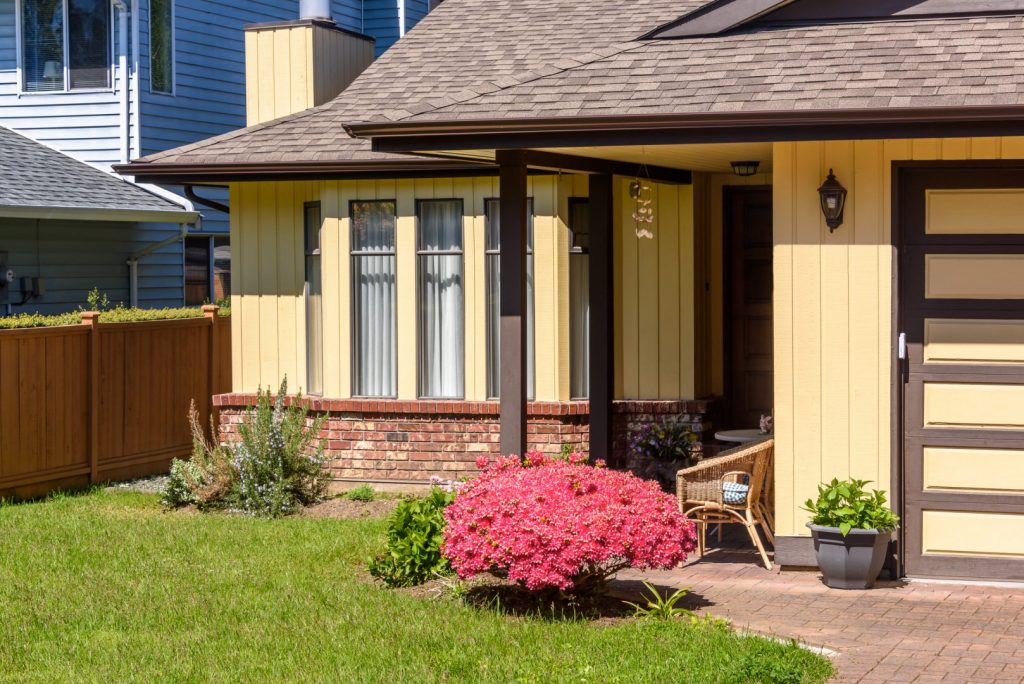
Items lining the walkway reduce the general access of someone approaching the entry door
To help people remain in their homes and age in place successfully, accessibility is a key concept – along with safety, comfort, and convenience. Accessibility comes in many forms, so let’s look at just how important it is and how it can be applied in aging in place designs. It easily is simplified just to apply to how someone gains entrance into the dwelling.
Clearly, accessibility means being able to get into one’s home, but there is a much larger concept. It’s a little like thinking that all we need to be able to drive a car is just sitting behind the wheel. Obviously, there is so much more to driving – opening the door, getting in, fastening the seatbelt, adjusting the position of the seat and the mirror, making sure there are no obstructions near or around the car, knowing how to start it and put it in gear, and then actually starting the car and going from there. Having a driver’s license, insurance, and good driving record are important aspects as well.
Getting into one’s home means opening the door and being able to transition well from the outside to the inside, but there are many considerations involved. What is accessible or usable to one person may not be for another because of sensory, mobility, or cognitive issues that limit their ability to understand what they need to do or to participate fully in using their space. If people have vision limitations, mobility restrictions, or cognitive impairments, whether a doorway is wide enough for them may not be the only issue.
We need to create a totally open environment that provides no impairments or impediments to approaching, entering, and using a dwelling. This means that from the time they get on the property – from the sidewalk, a corner or the yard, or the driveway – that they can get to the front door without encountering any challenges such as broken, uneven, or disconnected pavement, pavers, or walkways and that there is nothing interfering with their footing such as tree roots, fallen leaves, branches, other plant material (blossoms or seeds, for instances), rocks, mulch, grass, or weeds.
Once they get to the area of the front door, have they had to climb a series of steps leading from the perimeter of the yard to where they are now? If not, are they several steps awaiting them to get to the stoop, landing, or porch? Once there, if they can successfully climb those steps or stairs, is there a sufficiently large area for them to stand and await entry into the home? Can the entry door open without having them move out of the way of it swinging toward them? If it is raining or snowing, is there a large enough covering to protect them from falling – and blowing – participation so that they are not unduly uncomfortable while they wait and so that they can enter without allowing that moisture to come inside with them when the door is opened?
Let’s say that someone can get inside the home – the occupants of the home or visitors. What happens next, Can them move around freely or is there some type of restriction – a noticeable transition from room-to-room, from flooring surface-to-surface, up or down? Is the flooring reasonably firm without a lot of give or softness that could affect someone’s balance or step? Are the doorways wide enough (preferably at least three-feet in width) to allow easy passage? If there are doors that need to be opened or closed (closets or bathrooms, for instance), is the hardware something that can be used easily and do the doors open freely without a lot of physical effort?
In areas like the kitchen where there are shelves above the countertop for storage, can they be reached by everyone, or are some of them out-of-play because of their height from the floor? Can people reach, retrieve, hold, grasp, bend, squat, stand, sit, rise, lift, and perform other movements required to use shelves, drawers, and furniture in the home, or are they limited in what is available to them?
This is a partial picture of total accessibility is in a home – for those who live there as well as any visitors or guests. It goes well beyond just getting through the front, side, or back door into the home. They must have a quality of life inside the home as well. If the home constantly rebuffs their efforts to use it (shelving, cabinetry, furniture, appliances, bath fixtures, or wall controls) it is not accessible, and they will not feel welcome. No one – visitor or occupant – wants to feel intimidated by a home, We owe it to all to have homes be as accessible as possible. Some are going to require much more work and a considerably larger budget to make it happen, but we must be willing to try to achieve this.
